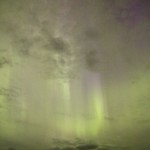As our Sun continues through the current solar maximum we should have plenty of opportunities to view one of the most sublime of all natural spectacles, the Aurora Borealis.

Solar Activity
Solar activity waxes and wanes in an eleven year cycle. When active there are increased numbers of sunspots and solar flares. It is this activity that can have such a dramatic effect here on Earth. A strong solar flare can be accompanied by a release of enormous quantities of material from the Sun. Called a coronal mass ejection (CME) this material streams outwards from the Sun. If the Earth happens to be in the path this material will strike the Earth’s magnetic field, causing the field to distort and reverberate with the impact. Charged particles are channeled into the atmosphere along the magnetic field to create a glowing spectacle.
Our current solar maximum should run through 2013 and into 2014 providing excellent auroral viewing conditions for the next year or two.
Viewers in the western hemisphere have an advantage, as the Earth’s magnetic pole is not located at the geographic pole. Since the pole is offset to the west, located in northern Canada, the auroral circle also tilts to the west. This allows western hemisphere viewers at lower latitudes to enjoy the aurora more easily than viewers across the eastern hemisphere, including northern Europe and Russia.
Getting Informed
There a several ways to get updates on current solar activity and the related activity in the Earth’s magnetic field. In this connected age you can get near real time warnings of CME’s and geomagnetic storms, you can know when to step outside and look up for the show.
The information is available on several good websites, my favorite is SpaceWeather.com for general information and reports of current activity. Down the left side of the main page you can find current data on solar activity, sunspots, recent flares and the corresponding level of activity in the Earth’s magnetic field. There are also photos and reports of current activity, including often stunning photography contributed by readers around the world. A menu at the top allows you to step back to past reports by date.

For immediate alerts there is a smart phone application from the NASA Heliophysics Division called 3D Sun. Available for both Android and iOS. This is my primary method of getting alerts to interesting solar conditions. The application can be set to receive push alerts that pop up, a quick reminder to look for aurora.
When looking at the reports there is a simple number that indicates current activity in our magnetic field. Called the K-index, this is an auroral strength measurement that ranges from zero to nine and is tied to a specific geographic location. Kp, the planetary K-index, is a averaged value from a number of stations giving a more general indication of auroral strength. A low Kp, zero to three indicates fairly calm conditions. It is when the Kp climbs above four that aurora watchers take note. The strong storm mentioned above, with aurora seen in the central United States featured a peak Kp of seven.
Armed with a little knowledge and a real time source for current conditions, you can be forewarned and ready to observe the aurora. This might mean the difference between catching the show, or accidentally sleeping through it.

